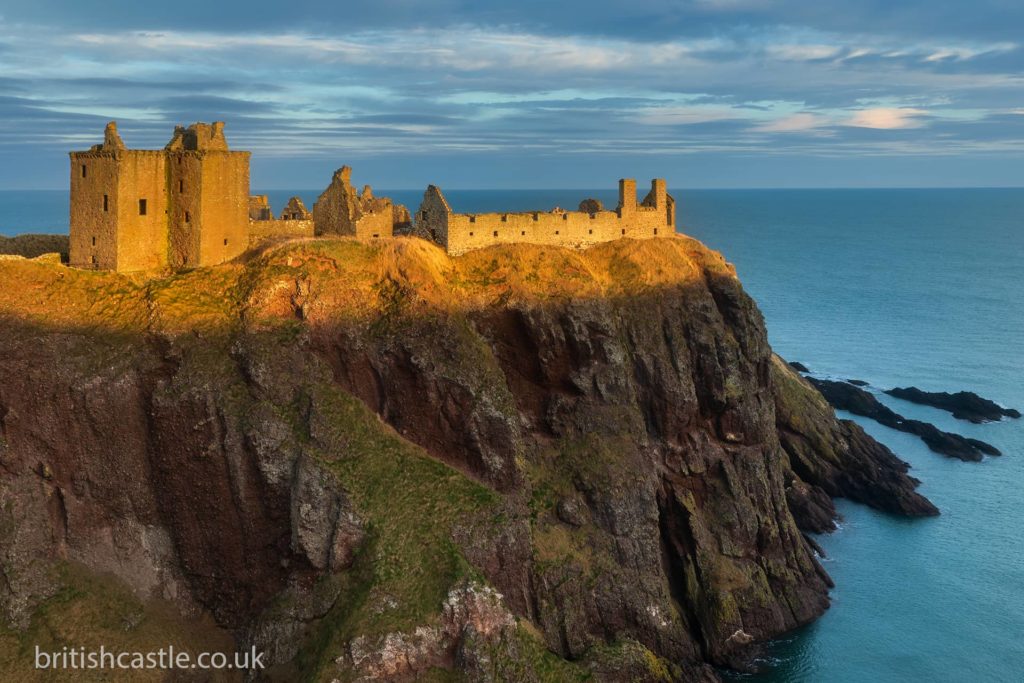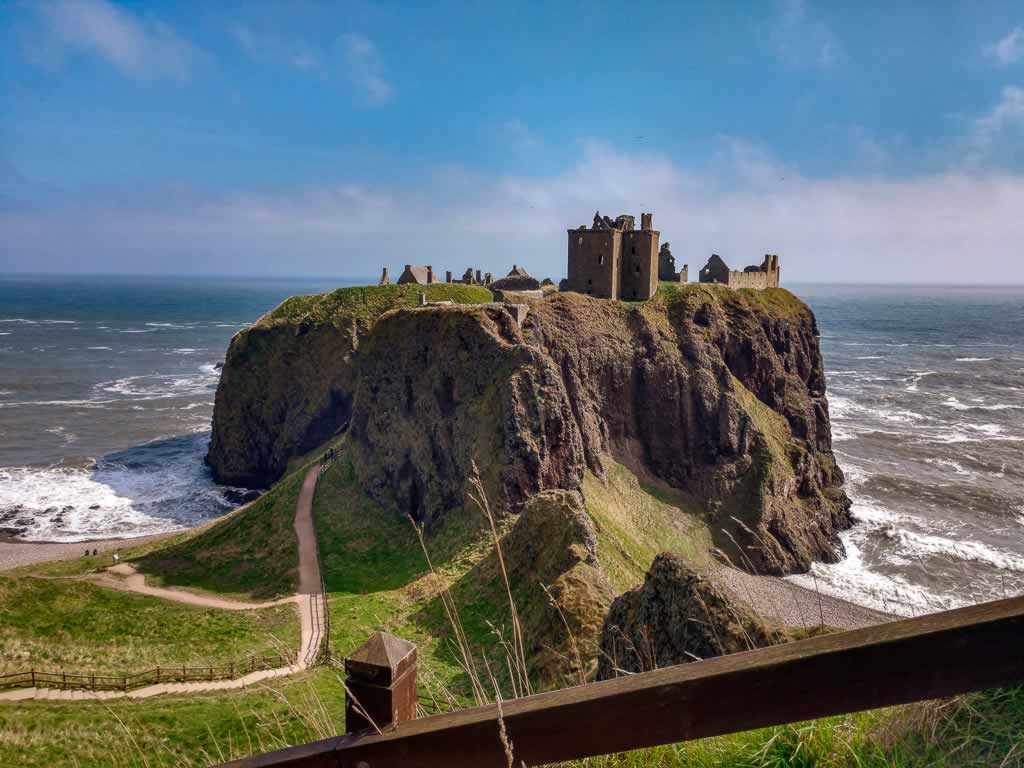On an ancient outcrop of rock 160 feet high stands the historic Castle Dunnottar, looking down from the sheer cliffs upon jagged rocks dashed by a cold east coast sea and separated from the mainland by a narrow pathway. This haunting ruin, steeped in history and surrounded by the North Sea, captivates photographers, history enthusiasts, and tourists from around the world.
Pictish Origins
There is evidence of Pictish inhabitation of a promontory fort at the site and it was here that St Ninian is thought to have come in the fifth century to spread Christianity and to build a smallholding and a chapel in a place of quiet contemplation, taking advantage of its seclusion and isolation from the mainland.
It was a peace soon shattered by the imminent struggles for power and dominance that feature throughout Scottish history.

Vikiing Raiders
The first documented threat to the fort came in the tenth century, during which time Viking raiding parties were racketing round the coastlines and islands of Scotland, Ireland and England.
King Donald II and his army attempted to fight off the Vikings at Dunnottar and Donald was killed in battle. The Vikings took possession, destroying the fortifications that existed at the time.
Religious contemplation
By the twelfth century the island had again become a site of sanctuary and religious contemplation, and the first stone chapel which still exists today dates from 1276.
It was here in 1296 that English soldiers hid during the bloody Wars of Independence to escape the fury of William Wallace and his armies, but their sanctuary turned out to be their final resting place.
Wallace set fire to where they were hiding in revenge for the wholesale slaughter of the Scots, sworn to the death against a Union between England and Scotland.

Occupation of the castle passed between the English and the Scots until the fourteenth century, when the title of the Earl Marischal and lands of Dunnottar were granted to William Keith by James II of Scotland. This was a powerful position with immense authority and responsibility.
The Earls Marischal had full command over the king’s protection, the security and organisation of national events, and the safekeeping of the Scottish Crown Jewels, the Honours of Scotland. These are a sword and sceptre, presented to James V by Pope Julius II to signify his favour towards the Kingdom of Scotland, and the crown.
Keith fell out of favour with the Bishop of Montrose who excommunicated him for having built a castle on what was considered to be holy ground. It took a personal petition to Pope Benedict XIII in 1394 pointing out that he had also included a church on the site, before the Pope agreed to reverse his excommunication on the understanding that he made large sums of money available to the church.
English Civil War
Dunnottar Castle, a medieval fortress perched on a rocky headland in Scotland, played a pivotal role during the English Civil War, especially in safeguarding the Scottish Crown Jewels. So precious were the Honours of Scotland that following the execution of Charles 1 in 1649 and the haste with which the coronation of his son Charles II at Scone Palace was organised, the Honours of Scotland had to be hidden from Oliver Cromwell.
He pursued Charles II with the vow to destroy any monarchic regalia as well as laying siege to and destroying the lands and castles of the Scottish nobility.
By the time of the coronation, Edinburgh was under siege by Cromwell’s men, and rather than take the jewels and state papers back there it was thought safer to hide them in the great fortress at Dunnottar, under the care and protection of the Earl Marischal.
So strong were the defences of the castle against Cromwell’s siege when he discovered their hiding place, that it took eight full months before the castle fell, but not before some quick thinking and sleight of hand had whisked the jewels away to Kinneff Church a few miles further south, where they remained hidden for years under the floor until the Restoration in 1660 and were returned to Edinburgh.
In 1685, during the period when the castle was being used as a prison as well as a defensive fortification, 167 Covenanters were incarcerated in a dank cell within the castle walls and starved for refusing to acknowledge the King as the head of the church. Out of the 167, only 35 finally capitulated. The rest either died whilst trying to escape, starved to death, or died en route to the West Indies to be banished from the kingdom for life.
Jacobite Rebellion: A Chapter in Scotland’s Colourful Past
By the time of the Jacobite Rebellion the mood in Scotland was raw; the Earl Marischal was damned as a traitor in 1716 for supporting the Jacobite cause and the call for a Scottish monarch independent of England, and Dunnottar Castle was seized. He lost his title and lands and once the castle was empty it slowly fell into disrepair and ruin.
For over three hundred years the castle stood empty, until in 1925 the Cowdray family bought the island and castle buildings; it remains in their hands today and is a privately owned Scheduled Ancient Monument of immense historical interest. Access to parts of Castle Dunnottar is restricted and it is not suitable for disabled access, given the layout of the access path and the buildings.
To find out more visitor information including opening times, ticket prices visit HeritageXplore Dunnottar Castle page and book a visit.
Dunnottar Castle History
Historical Timeline of a Romantic and Haunting Ruin
- 557 St Ninian comes to Dunnottar
- 900 King Donald II killed in battle with Viking raiding parties
- 1276 First chapel built and consecrated on the island
- 1296 William Wallace traps English soldiers in the chapel and sets fire to it
- 1390 First stone tower built on the island
- 1394 Pope Benedict XIII revokes Keith’s excommunication in return for donations to the church
- 1649 Charles I executed
- 1650 Charles II crowned King of Scotland and England
- 1685 Covenanters imprisoned for refusing to recognise the king as their spiritual leader
- 1716 The Earl Marischal loses his lands and title for backing the Jacobite cause
- 1925 Castle bought by the Cowdray family
Read more about other Scottish Castles.